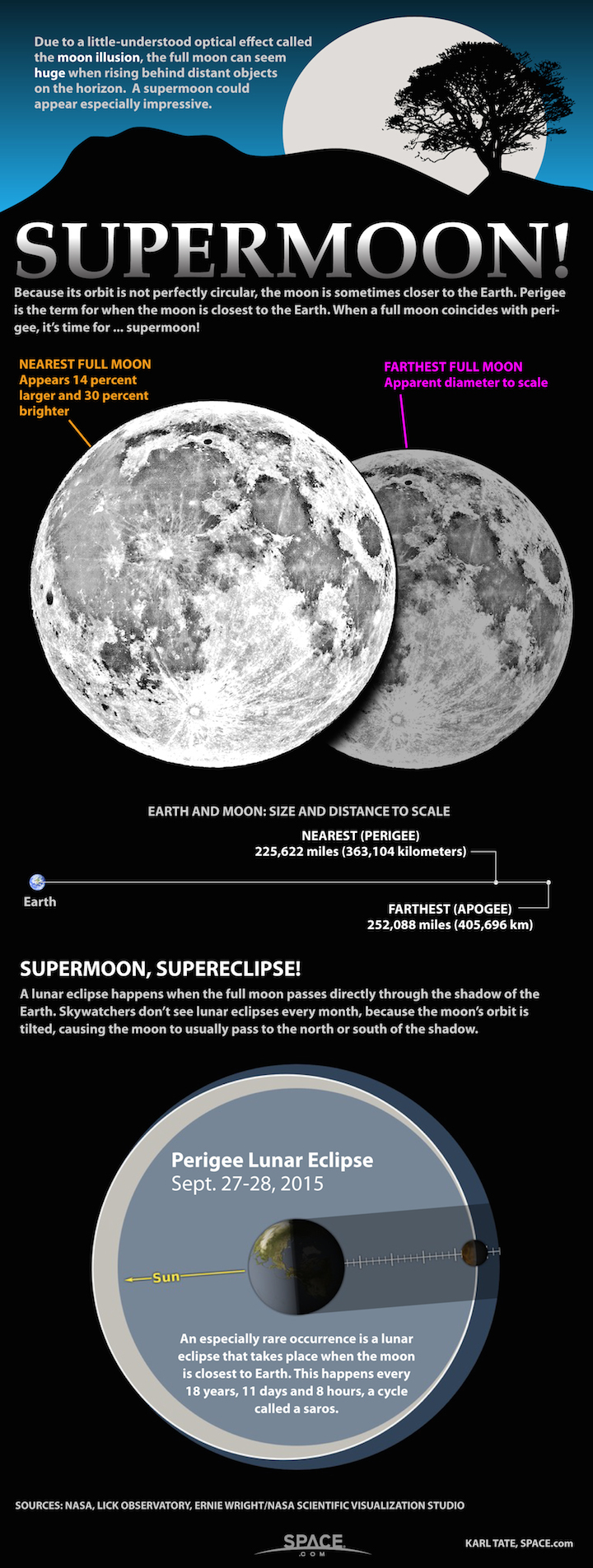29.12.2017
The January full moon is traditionally called the Full Wolf Moon in the Northern Hemisphere, according to the Old Farmer's Almanac. In 2018, it occurs on Jan. 1 at 9:24 p.m. EST (0224 GMT). [Note: In Europe and Asia, the full moon occurs Jan. 2 due to time zone differences.] Moonrise in New York City that day is at 4:34 p.m. local time, just a few minutes before sunset which happens at 4:39 p.m. So the Wolf moon will briefly share the sky with the sun, though you'll need a view of a relatively flat, unobscured horizon to see it happen.
January's full moon will also occur just hours after the moon reaches perigee, its closest point to Earth in its monthly orbit, making it a so-called supermoon. At its closest point on Jan. 1, the moon will be 221,559 miles (356,565 kilometers) from Earth. On average, the moon is about 238,000 miles (382,900 km) from Earth, though its orbit is not perfectly circular. For more on the Jan. 1 supermoon, read our full guide:
Supermoon 2018: When and How to See January's Two Full Moons
The Wolf moon rises
The Wolf moon (when it reaches full phase) will be in the constellation Gemini, according to heavens-above.com, roughly along a line between Pollux (Beta Geminorum) and Betelgeuse (Alpha Orionis). The moon is so bright that it will make the deep sky objects nearby — the Orion nebula, for example — a bit harder to see if the sky isn't perfectly clear.
An interesting artifact of celestial motions is that on that first full moon night, none of the traditional naked-eye planets — Mercury, Venus, Mars, Jupiter or Saturn — will be visible at all from the northeastern U.S. when the moon reaches full phase. Mars and Jupiter don't rise in New York City until the morning of Jan. 2 at 2:54 a.m. and 3:04 a.m. local time, respectively, and Saturn doesn't poke above the horizon until 6:37 a.m., just about 42 minutes before sunrise.
That second full moon has also been dubbed a "supermoon" — a full moon that roughly coincides with perigee, the point in the moon's orbit when it is closest to Earth. In January the moon reaches perigee on the night of Jan. 30, and reaches peak fullness on the night of Jan. 31.
The moon's distance from Earth can vary a bit because the orbit isn't perfectly circular, so even though the average distance is 238,855 miles (384,400 kilometers) on Jan. 30 it will be only 221,559 miles (356,565 kilometers) away. On average, the apparent size of the moon in the sky is about 0.5 degrees across, or about 31 arcminutes. (Check out Space.com's guide to measuring distances on the sky for more information.) During this supermoon, though, our lunar neighbor will be 33.51 arcminutes across, or 0.56 degrees. As a result, it will appear 11 percent larger than an average full moon. For most skywatchers, that difference is difficult to see.
The month's second full moon, on Jan. 31, will feature a total lunar eclipse, or a "blood moon.". If you live in the western U.S., Hawaii, or the Eastern half of Asia, you'll see the moon turn blood-red as it enters the deepest parts of the Earth's shadow during the eclipse. A total lunar eclipse is one where the moon passes through the central region of the shadow of the Earth, which describes a cone that stretches away from the sun. At other times the moon only passes through the shadow partway, and that's a partial lunar eclipse.
During a total lunar eclipse, the surface of the moon appears to turn red because red light that passes through the Earth's atmosphere is bent; the atmosphere is acting like a lens. In addition, red light is scattered less than blue. So the red light makes it through and shines on the lunar surface, even though the moon is in shadow. This is the same mechanism that makes sunsets look red – at sunset the sun's light has to pass through more of the Earth's air and the shorter-wavelength blue parts of the spectrum are scattered away.
Some places on Earth will feature a spectacular view of the blood moon rising or setting on the day of the eclipse. Observers on the East Coast of the U.S. on Jan. 31 won't get that — the moon will only just be entering the darker part of the Earth's shadow when it sets at 7:04 a.m. in New York City. (Fullness occurs at 8:26 a.m. local time in New York, but the moon will be out of view then). On the other hand, if you are in Chicago, the eclipse will reach its maximum at 6:56 a.m. local time, and the moon will be setting at 7:03 a.m. As one moves west, the eclipse happens earlier in the evening, and by the time one reaches Hawaii the entire eclipse is visible well before the moon sets (at 7:19 a.m. local time in Honolulu).
If you live in Moscow or locations roughly on a northwest-to-southeastern line from there, the moon will be emerging from the Earth's shadow as it rises. This line marks the "terminator" of the Earth – the line between the day side and night side. (It's not straight north-south because the Earth is tilted on its axis).
In Moscow, moonrise is at 5:01 p.m. local time and the moon will still look red for another six minutes. Moving aoutheast to Karachi, the view is better; at 6:13 p.m. local time the moon rises, and it reaches the maximum eclipse at 6:29 p.m., making for some spectacular photo-ops.

Quelle: Space Com
